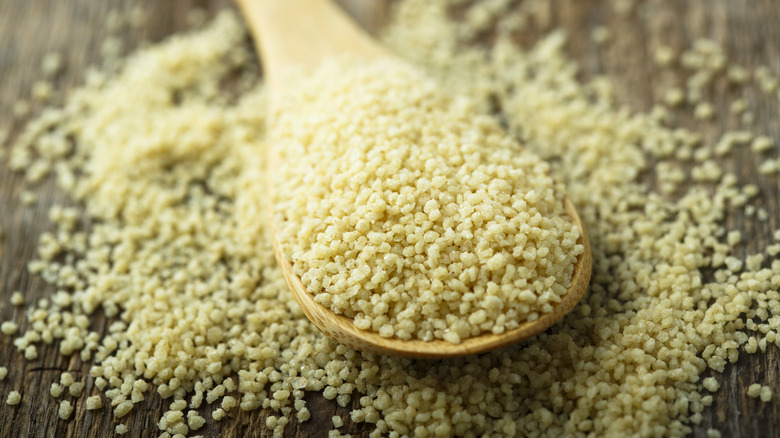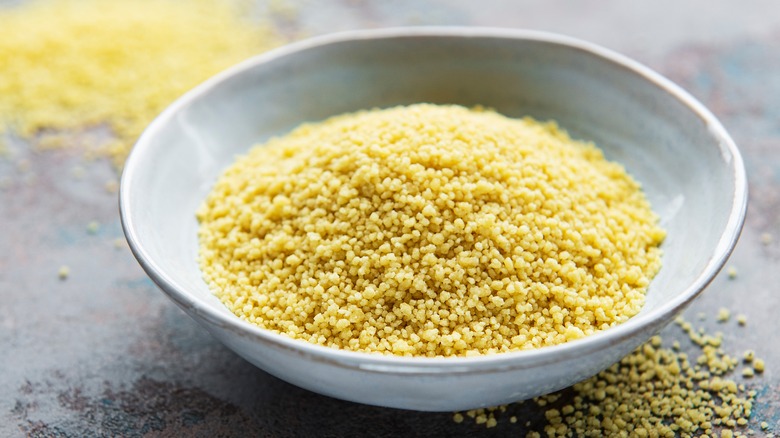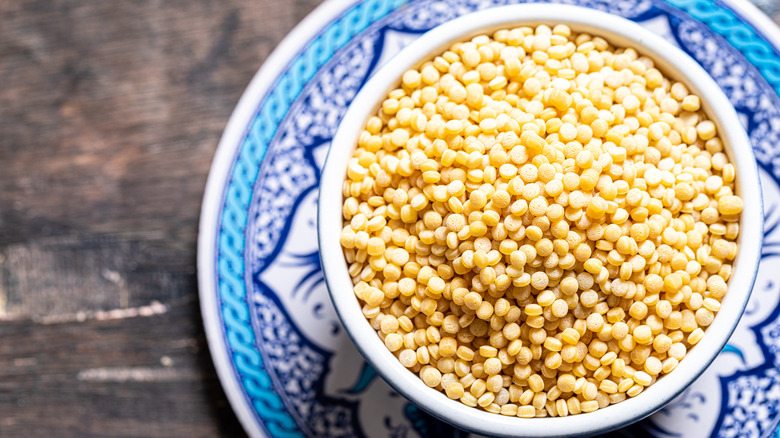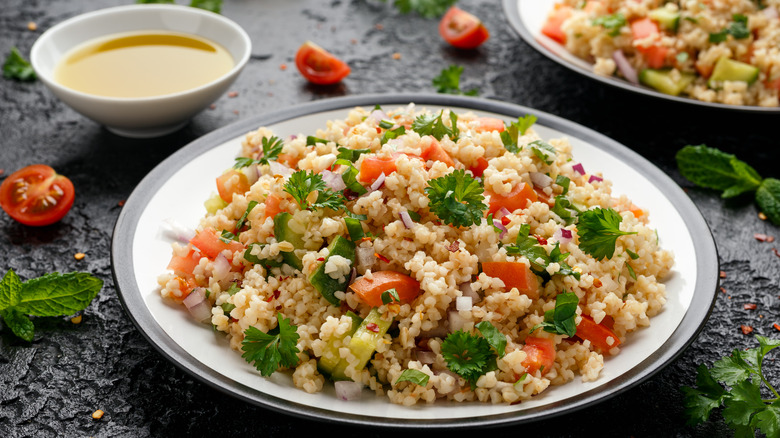Couscous Vs. Israeli Couscous: What's The Difference?
The dawn of a new year often inspires a flurry of well-intentioned resolutions to do better and be better. Promises are made to go on more walks, to meditate before sending scorched-earth emails, or to eat healthier. According to Good Morning America, a great place to start for better eating is the Mediterranean Diet, the healthiest ranked diet six years running.
Unlike other diets, it doesn't exclude any one food group but emphasizes a plethora of vegetables and fruits and a good amount of protein and healthy fats, like olive oil and nuts. While Mediterranean cuisine may call to mind Greek and Italian dishes, this diet also relies heavily on Maghrebi (Northwest African) food, including aromatic shakshouka and tagine recipes(via Halal Trip).
As you become acquainted with this cuisine, one ingredient will consistently pop up: couscous. Fun to say and tasty to boot, couscous is relatively easy to find at the grocery store. Still, you may run into a little bit of a problem if you see it sharing counter space with the similarly named but radically different product, Israeli couscous. What's the difference between the two?
Couscous is small and similar to rice
What's in a name, anyway? The etymological origins of couscous could be one of two things. The Baltimore Sun reports the word could be onomatopoeic, with the pronunciation "koos-koos" imitating the hissing sound of the steam escaping from the holes in the couscousière (the pot in which the couscous is cooked).
Or, the word could be a derivative of the African expression for "pecked at," as the tiny grains resemble bird feed. Either way, couscous has been a staple dish of the Maghreb region since the 13th century and acquired intangible cultural heritage status from UNESCO in 2020 (via The Washington Post).
The ancient process for creating couscous begins with semolina, essentially coarsely ground durum wheat. Lightly sprinkled with water, the mixture is rolled between the palms to make small, irregular granules. Whether this throws it into the pasta category is up for debate, as couscous is made like pasta but cooked and treated like rice (via the Washington Post).
Cooking-wise, Once Upon a Chef reports that steaming traditional couscous in the multi-chambered couscousière is time-consuming. Luckily, the couscous sold in the United States is partially pre-cooked, meaning it often comes together in less than five minutes (just don't forget to let couscous rest a bit after cooking). Nutty and mildly sweet, couscous provides the perfect blank canvas for many Mediterranean dishes.
Israeli couscous is larger and has a toasted flavor
The main difference between couscous and Israeli couscous? Israeli couscous isn't really couscous at all. According to MasterClass, couscous and Israeli couscous have the same ingredients but differ in their production, with the latter being entirely machine-produced while the former was traditionally handmade. Made from wheat flour and water, Israeli couscous goes by several names, including pearl couscous, giant couscous, and ptitim (the Hebrew word for "flakes"). Why is it associated with Israel rather than Italy if it's technically pasta?
The Nosher notes that the creation of Israeli couscous is intertwined with the birth of the Israeli nation in the mid-20th century. Not long after the War of Independence, the Israeli government sought to provide its growing populace with a cheaper alternative to rice. Osem, the Israeli food manufacturer that Prime Minister David Ben-Gurion assigned to the task, came up with a ptitim, pasta beads made of dried wheat paste. Once boiled in water, the hard beads transform into a soft, bouncy side dish that straddles the line between pasta and rice.
Israeli couscous is markedly larger than plain couscous and lacks the butter-yellow hue signature of its diminutive namesake. Beyond size and color, the Nosher writes that Israeli couscous has a more toasted-wheat flavor, as the pasta pearls are toasted before drying and packaging. MasterClass also notes that Israeli couscous offers a much chewier texture than plain couscous.
A guide for couscous substitution
Which couscous should you be using? And is there ever a time when you can swap the two in a recipe? It depends on what is more important for your dish, flavor or texture.
Escoffier notes that both couscous and Israeli couscous offer a neutral backdrop for strong flavors, so a swap won't drastically affect the taste. They both can be used as an accompanying grain to salads or as an absorbent bed for a Moroccon chickpea stew or braise. However, couscous is a finer grind, sharing more in common with quinoa than Israeli couscous in terms of texture.
If Israeli couscous is required to make a creamy, chewy take on risotto, regular couscous will not work as a substitute. Escoffier also writes that this departure in size means that the two are not good swaps when stuffing vegetables (opt for couscous) or beefing up the heartiness of stews (use the plumper Israeli couscous).
Either way, both varietals are worth exploring as a tasty gateway to Mediterranean cuisine.



